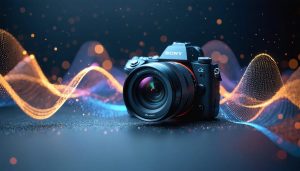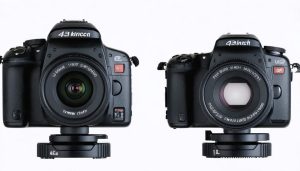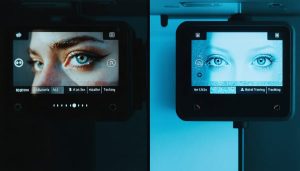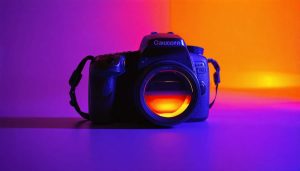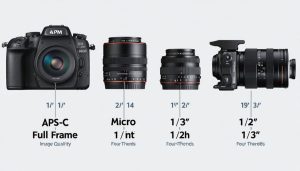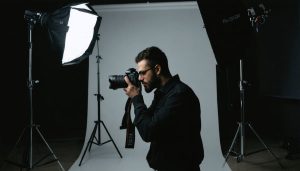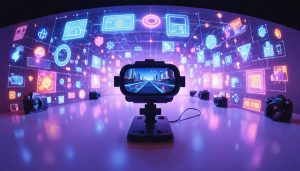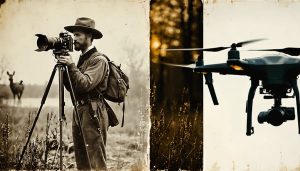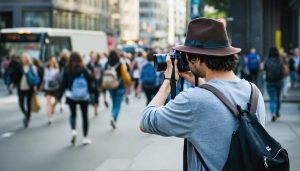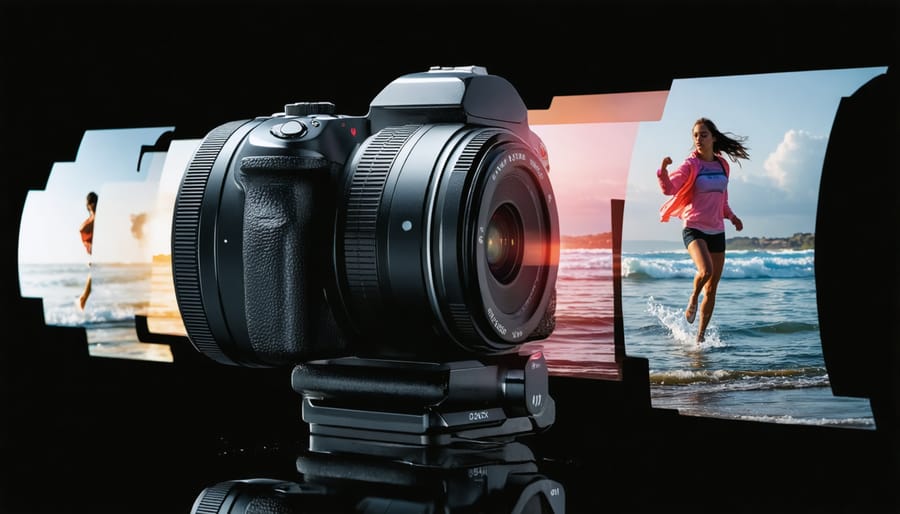
Auto focus sensors represent one of the most significant advances in modern camera sensor technology, transforming the way we capture perfect moments in a fraction of a second. Working silently behind the scenes, these sophisticated arrays of sensors continuously analyze light patterns, contrast differences, and subject movement to deliver razor-sharp images even in challenging conditions. Whether you’re tracking a bird in flight or capturing a bride’s first dance, today’s AF systems combine phase-detection and contrast-detection methods to achieve focus speeds and accuracy that were unimaginable just a decade ago. For professional photographers and enthusiasts alike, understanding how these sensors operate isn’t just about technical knowledge—it’s about mastering a tool that can mean the difference between a missed opportunity and a masterpiece. As cameras become increasingly sophisticated, auto focus sensors have evolved from simple center-point systems to complex networks capable of real-time subject recognition and tracking, fundamentally changing how we approach photography in both studio and field conditions.
The Evolution of Autofocus Technology
Traditional AF Sensors
Traditional autofocus systems primarily rely on two methods: phase-detection and contrast-detection. Phase-detection AF uses specialized sensors that split incoming light into pairs of images. When these paired images align perfectly on the sensor, the subject is in focus. Think of it like bringing two puzzle pieces together – when they match perfectly, you’ve got sharp focus. This method is typically faster and works better in low light, which is why it’s been a staple in DSLR cameras.
Contrast-detection, on the other hand, works by analyzing the contrast between adjacent pixels in your image. The camera adjusts the lens until it finds the point of maximum contrast, which indicates optimal focus. While this method can be more accurate, it’s generally slower because the lens needs to hunt back and forth to find the highest contrast point. It’s like adjusting a microscope’s focus knob until the image looks sharpest.
Most modern cameras combine both methods to leverage their respective strengths, providing photographers with reliable autofocus performance across various shooting scenarios. This hybrid approach has become increasingly sophisticated, leading to the development of more advanced AF systems we see today.
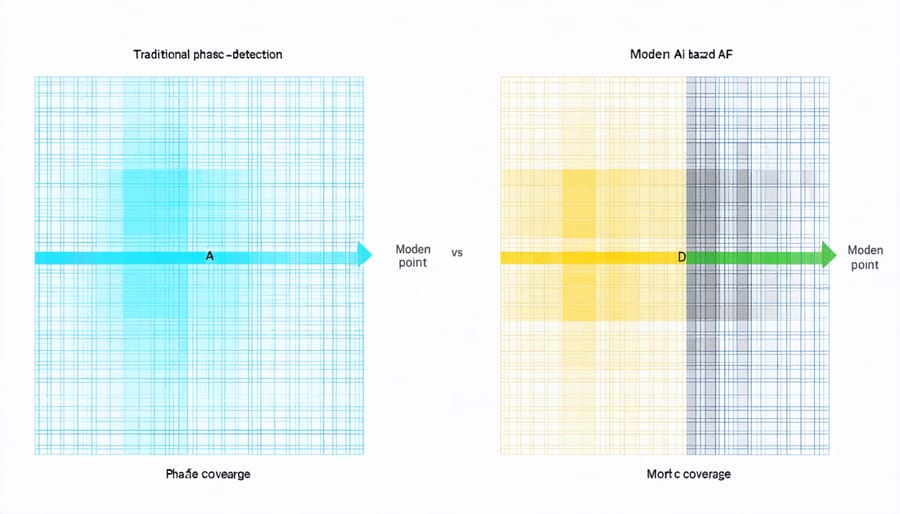
The AI Revolution in AF Systems
Artificial intelligence has revolutionized autofocus systems, bringing capabilities that seemed like science fiction just a few years ago. Modern AI-powered AF systems can recognize and track subjects with remarkable precision, making split-second decisions that outperform traditional contrast-detection methods.
The game-changer lies in deep learning algorithms that can identify and track specific subjects – from human eyes and faces to animals and vehicles. These systems analyze countless images during development, learning to recognize patterns and features that define different subjects. As a result, today’s cameras can lock onto a bird in flight, maintain focus on a race car, or track a performer’s eye during a stage performance, all while adapting to changing conditions in real-time.
What makes AI autofocus truly revolutionary is its ability to learn and improve. Camera manufacturers regularly release firmware updates that enhance AF performance based on real-world usage data. This means your camera’s autofocus capabilities can actually get better over time – something unheard of in the pre-AI era.
For photographers, this translates to more keepers and the ability to capture moments that might have been impossible before.
How AI-Powered AF Sensors Work
Subject Recognition and Tracking
Modern autofocus systems leverage sophisticated AI algorithms to identify and track subjects with remarkable precision. These systems can recognize various subjects – from human faces and eyes to animals and vehicles – often in a fraction of a second. The technology works by analyzing countless image frames in real-time, using deep learning models trained on millions of sample images.
When you point your camera at a scene, the AI first performs a rapid subject detection sweep. For human subjects, it typically prioritizes faces and eyes, creating a hierarchical focus map. The system can distinguish between multiple faces in the frame and even maintain focus on specific individuals as they move through a crowd.
What’s particularly impressive is how these systems handle complex scenarios. For instance, when photographing wildlife, the AI can identify not just the animal’s body, but specific features like eyes or beaks, even when partially obscured by foliage. In sports photography, the system tracks athletes maintaining sharp focus despite rapid movements and changing directions.
The tracking capability works through predictive algorithms that anticipate subject movement. By analyzing patterns in real-time, the system can predict where the subject is likely to move next, adjusting focus accordingly. This is especially useful in scenarios like bird photography, where subjects move erratically and at high speeds.
Recent advances have also improved performance in challenging conditions like low light or backlit scenes. The AI can now maintain subject recognition and tracking even when contrast is poor, something that was particularly challenging for older autofocus systems.
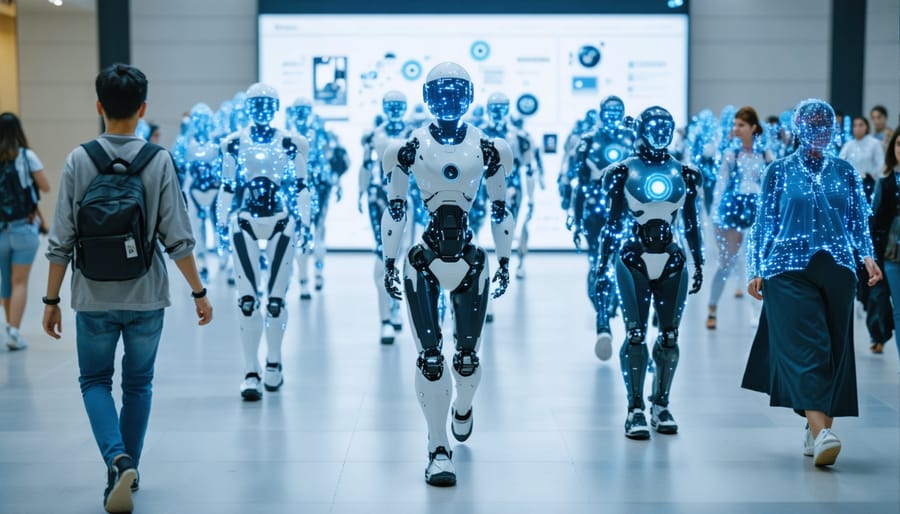
Deep Learning Integration
Deep learning has revolutionized autofocus systems, bringing unprecedented accuracy and speed to modern cameras. Neural networks, trained on millions of images, can now recognize and track subjects with remarkable precision, adapting to various shooting conditions in real-time.
These AI-powered systems excel at understanding complex scenes, identifying primary subjects, and maintaining focus even in challenging situations. For instance, when photographing a bird in flight, traditional AF systems might struggle with background distractions, but deep learning algorithms can instantly recognize and lock onto the bird, significantly improving both image quality and capture success rate.
The neural networks are particularly adept at human and animal recognition, capable of identifying and tracking specific body parts like eyes or faces, even when partially obscured. This breakthrough has transformed portrait and wildlife photography, where split-second focusing decisions are crucial.
What makes this technology truly remarkable is its ability to learn and improve over time. Camera manufacturers regularly update their AF algorithms, enhancing subject recognition capabilities and focusing performance through firmware updates. This means your camera actually becomes more intelligent and capable as time goes on.
For photographers, this integration means spending less time wrestling with focus points and more time composing shots. The system’s predictive capabilities can anticipate subject movement, maintaining sharp focus even in unpredictable situations. Whether you’re shooting sports, wildlife, or street photography, deep learning-enhanced AF provides a level of reliability that was previously unimaginable.
Real-World Benefits for Photographers
Action and Sports Photography
Action and sports photography demands lightning-fast focus acquisition, and modern AI-powered autofocus sensors deliver exactly that. These sophisticated systems excel at tracking athletes, vehicles, and wildlife with remarkable precision, even in challenging conditions. By utilizing advanced algorithms and machine learning, AI AF can predict subject movement patterns and maintain sharp focus when traditional systems might struggle.
What makes this technology particularly impressive is its ability to recognize and lock onto specific subjects. For instance, when photographing a soccer match, the AF system can identify and track individual players through complex movements, ensuring crisp shots even during rapid direction changes. The relationship between lens and sensor performance becomes especially crucial in these high-speed scenarios.
Modern AI AF systems also excel at eye detection, making them invaluable for sports portraits and action close-ups. They can maintain focus on an athlete’s eyes even during intense movement, resulting in compelling images that capture both action and emotion. The system’s ability to process information in real-time means photographers can focus more on composition and timing rather than struggling with manual focus adjustments.
For motorsports and fast-moving subjects, these sensors can track vehicles at speeds exceeding 200 mph, maintaining sharp focus through turns and straightaways. This level of performance was nearly impossible with older AF technology, making AI AF sensors a game-changer for action photographers.
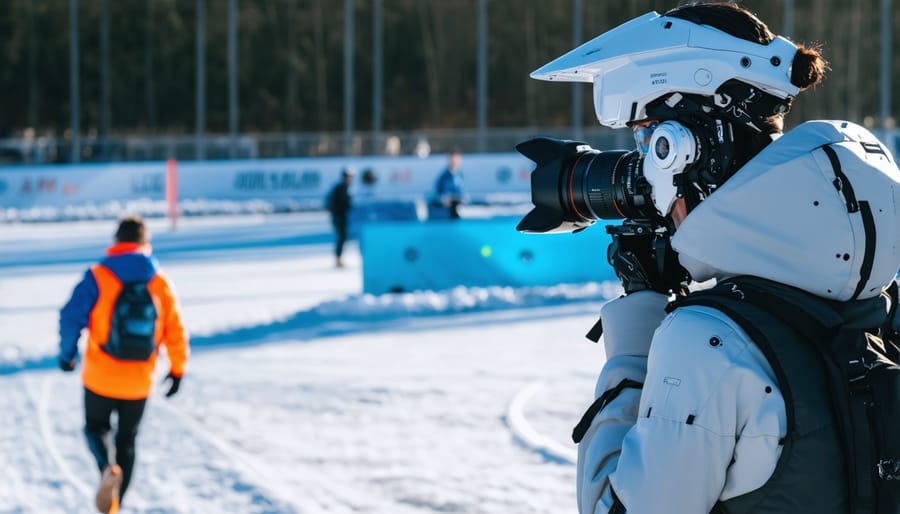
Portrait and Wildlife Photography
Modern autofocus sensors have revolutionized portrait and wildlife photography through sophisticated eye-tracking and animal detection capabilities. These intelligent systems can identify and lock onto human eyes with remarkable precision, even when subjects are in motion or partially turned away from the camera. This technology is particularly valuable for portrait photographers who need to maintain sharp focus on their subject’s eyes while creating natural, candid moments.
The advancement in animal detection is equally impressive, with current AF systems capable of recognizing and tracking various species, from common pets to wildlife. Whether you’re photographing birds in flight or capturing fleeting moments of big cats in their natural habitat, these sensors can maintain focus on animal eyes and faces with incredible accuracy. This is a game-changer for wildlife photographers who often work in challenging conditions with unpredictable subjects.
What makes these features particularly powerful is their ability to work in real-time, adapting to changing situations instantly. The system continuously evaluates the scene, predicting subject movement and adjusting focus accordingly. For instance, when photographing active children or restless pets, the AF sensor maintains focus even when subjects suddenly change direction or move erratically.
These capabilities significantly reduce the technical burden on photographers, allowing them to concentrate more on composition and timing rather than struggling with manual focus adjustments. The result is a higher keeper rate and more consistently sharp images, especially in challenging shooting scenarios.
Current Limitations and Future Developments
While modern autofocus systems have made remarkable strides, they still face several challenges that photographers need to navigate. Current AF systems can sometimes struggle in extreme low-light conditions, especially when dealing with different sensor types and their varying light sensitivity levels. Fast-moving subjects in complex backgrounds continue to pose difficulties, particularly when multiple objects cross the focal plane simultaneously.
Another limitation is the accuracy of eye and face detection in challenging scenarios, such as when subjects wear masks, sunglasses, or are partially obscured. Battery consumption remains a concern, as sophisticated AF systems demand significant power to maintain continuous performance, especially in mirrorless cameras that rely heavily on electronic viewfinders.
However, the future of autofocus technology looks incredibly promising. Manufacturers are developing more sophisticated AI algorithms that can better predict subject movement patterns and adapt in real-time. We’re seeing early implementations of deep learning systems that can recognize and track an expanding range of subjects, from specific animal species to vehicles, with unprecedented accuracy.
Emerging technologies are also addressing the power consumption challenge through more efficient processors and improved battery management systems. Some manufacturers are experimenting with hybrid AF systems that combine the best aspects of phase-detection and contrast-detection methods, while others are exploring entirely new approaches like quantum sensing technology.
One particularly exciting development is the integration of augmented reality elements into AF systems, potentially allowing photographers to visualize focus paths and predict subject movement before it happens. Advanced scene recognition capabilities are being developed that can understand complex shooting scenarios and automatically adjust focus parameters accordingly.
Despite these innovations, challenges remain in achieving perfect focus accuracy in all situations. The industry continues to work on improving low-light performance, reducing focus hunting in challenging conditions, and developing more intuitive user interfaces that allow photographers to maximize these advanced capabilities without getting overwhelmed by technical complexity.
As we look ahead, the key focus appears to be on making AF systems not just more accurate, but more intelligent and adaptable to different shooting situations while maintaining user-friendly operation. This balance between sophisticated technology and practical usability will likely define the next generation of autofocus systems.
As we look to the future of photography, AI-powered autofocus sensors represent more than just technological advancement – they’re revolutionizing how we capture moments. These intelligent systems have transformed from simple contrast-detection mechanisms to sophisticated networks that can recognize faces, track subjects across complex scenes, and anticipate movement with uncanny precision.
The impact of AI autofocus technology extends beyond professional photography into everyday image-making. Smartphone photographers can now capture professional-quality action shots, while wildlife photographers benefit from enhanced animal eye detection and tracking capabilities. This democratization of advanced focusing technology has opened new creative possibilities for photographers at all skill levels.
Looking ahead, we can expect AI autofocus systems to become even more intuitive and capable. Emerging technologies suggest future cameras might predict subject movement patterns, adapt to challenging lighting conditions instantaneously, and perhaps even understand the photographer’s intent through learned behavior patterns.
However, it’s important to remember that while AI autofocus sensors are powerful tools, they remain just that – tools in service of creative vision. The photographer’s eye, understanding of composition, and artistic judgment will always be the driving force behind compelling images. The real excitement lies in how these advanced focusing systems free photographers to concentrate more on their creative vision while ensuring technical precision.
As this technology continues to evolve, it promises to make photography more accessible while simultaneously pushing the boundaries of what’s possible in image capture.

